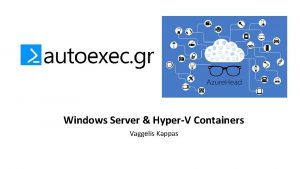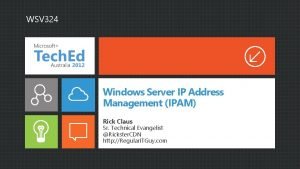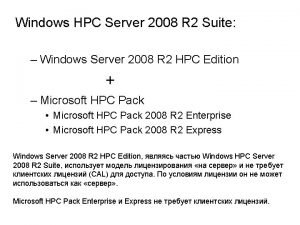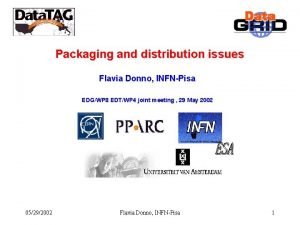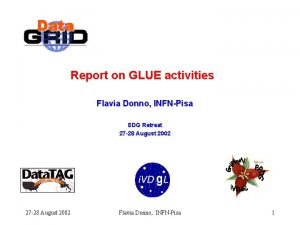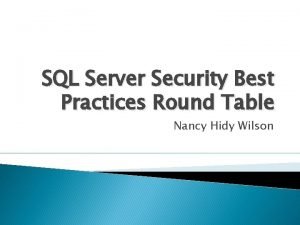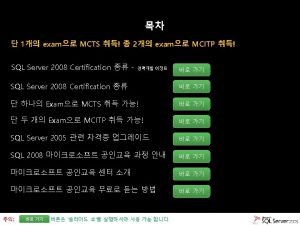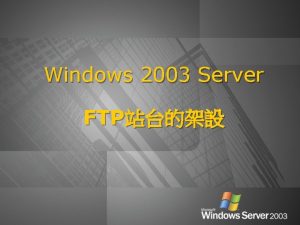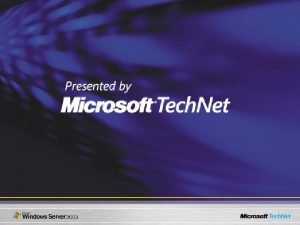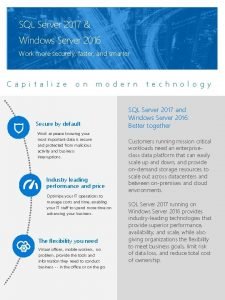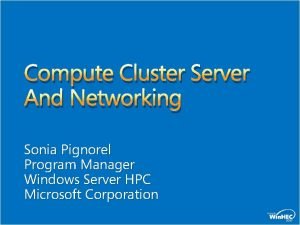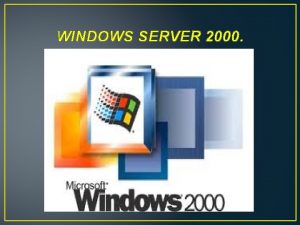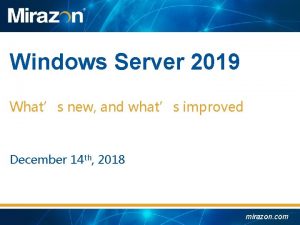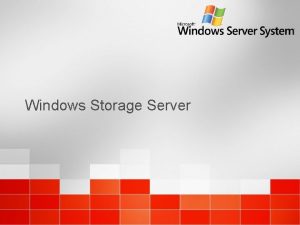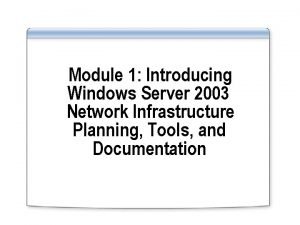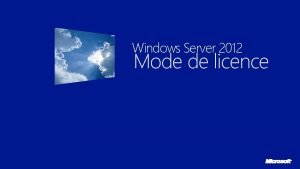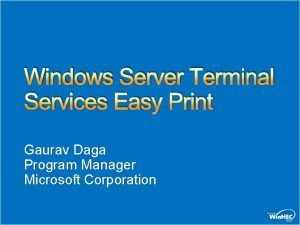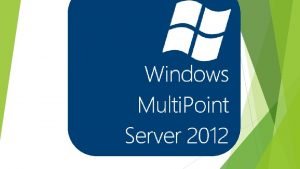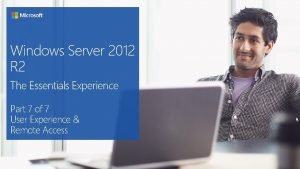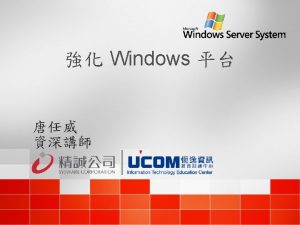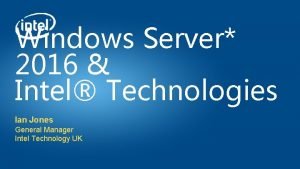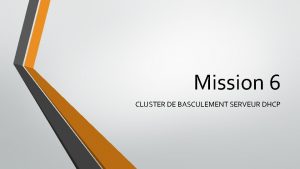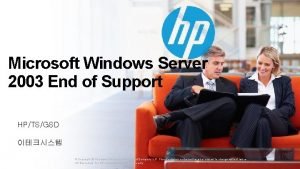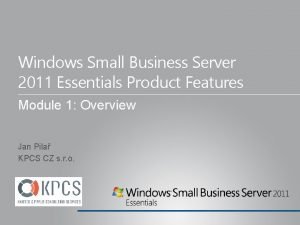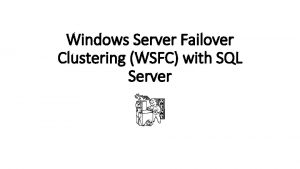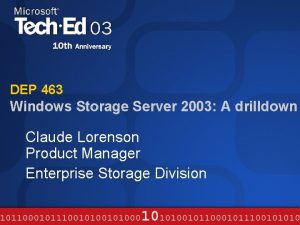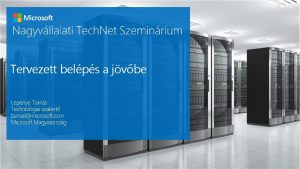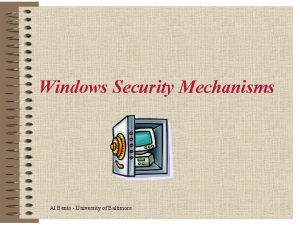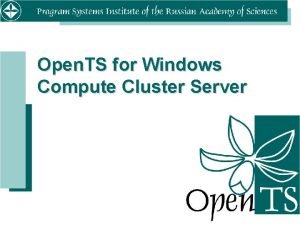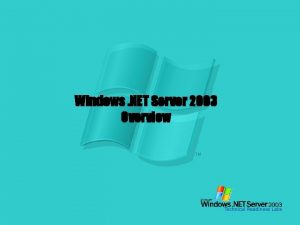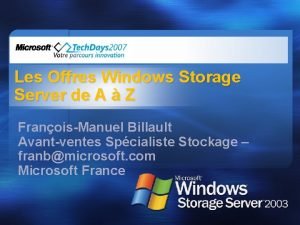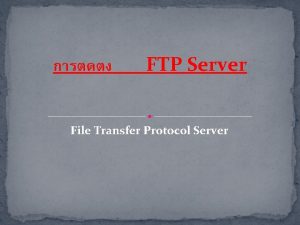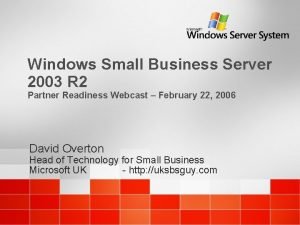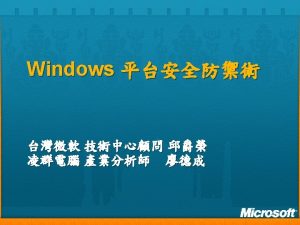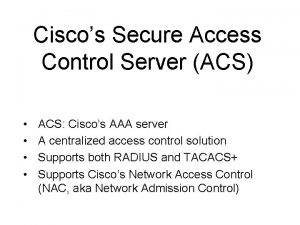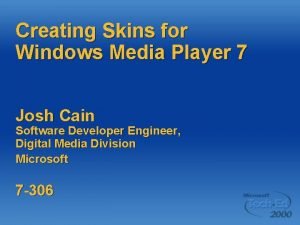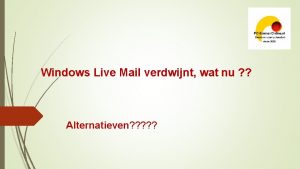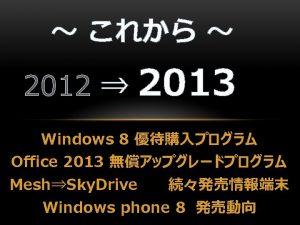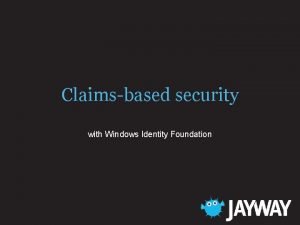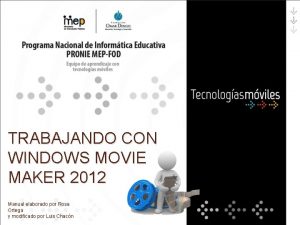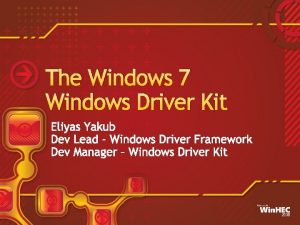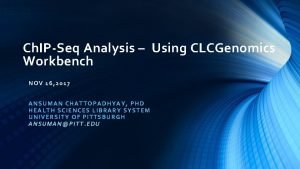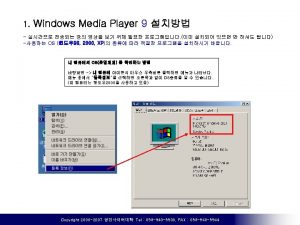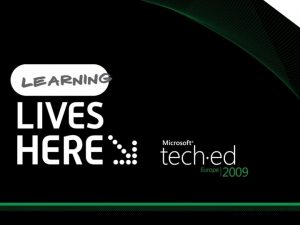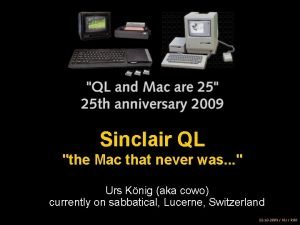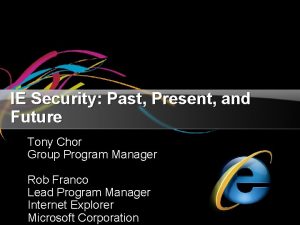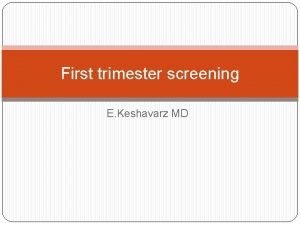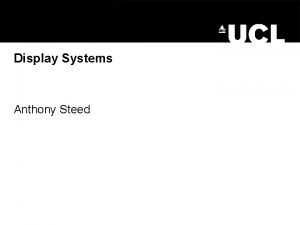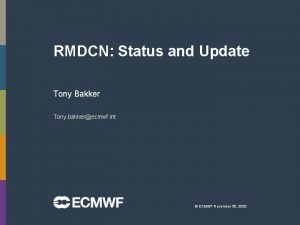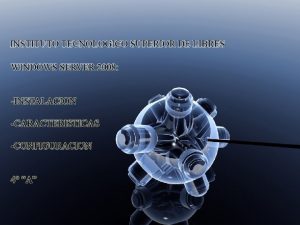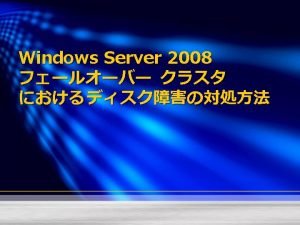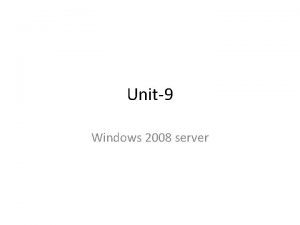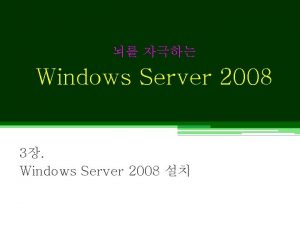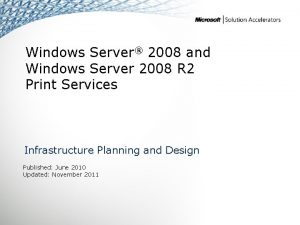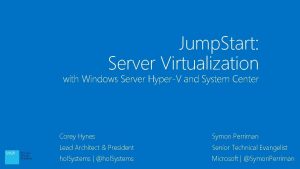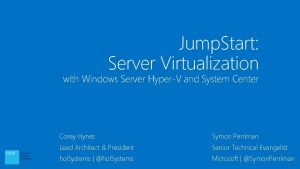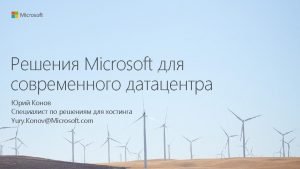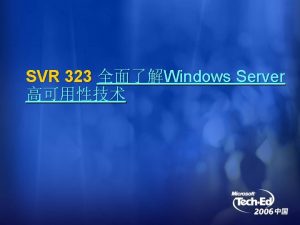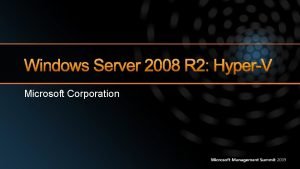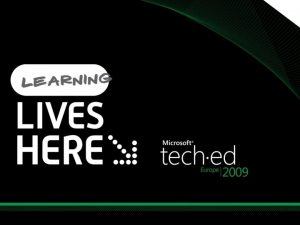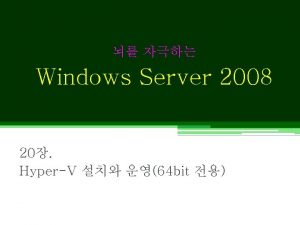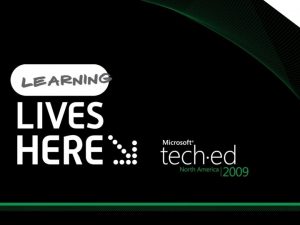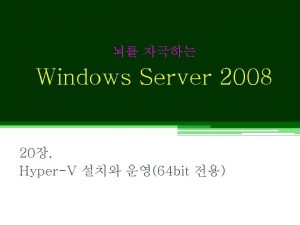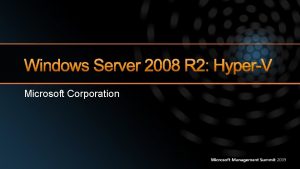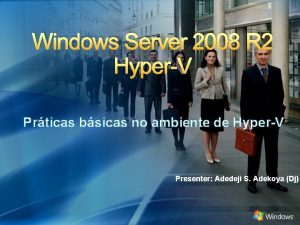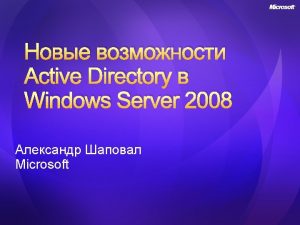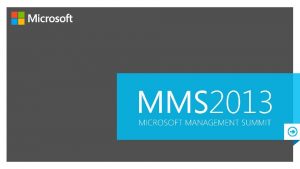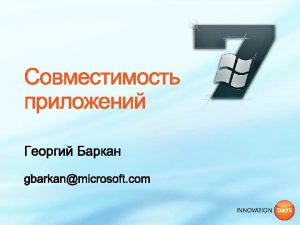Windows Server 2008 R 2 HyperV Tony Donno
































































- Slides: 64


Windows Server 2008 R 2 Hyper-V Tony Donno Principal Program Manager Microsoft VIR 207

Agenda Microsoft Virtualization Strategy/Portfolio Overview of Windows Server 2008 R 2 Hyper-V Features, features! System Center Virtual Machine Manager R 2 Microsoft Hyper-V Server 2008 R 2 Q&A

Microsoft Virtualization Strategy It’s the Platform you know Data center to desktop End-to-End Management Best TCO/ROI Key feature of platform Full range of products & solutions Physical and Virtual & Cross-hypervisor 1/3 the price up front Tools you know Large partner eco-system Interoperability Lower ongoing costs

Microsoft Virtualization Products From the Datacenter to the Desktop Server Virtualization Application Virtualization Presentation Virtualization Desktop Virtualization “Having one vendor for the hypervisor, operating system, and much of our application software was very appealing to us from a support and cost perspective. ” Bert Van Pottelberghe, Sales Director, Hostbasket User State Virtualization Document Redirection and Offline Files

Server Consolidation The Fastest Way to Reduce Costs Challenges: • Underutilized hardware • Excessive power consumption • Expensive space across datacenter and branch offices “We expect to consolidate an additional 75 servers using Hyper-V, which will lead to a cost savings of more than $325, 000 annually. By the time we hit our fifth virtual machine, we’ve usually paid for the host. Long term, we will be able to reduce our total data center holdings by 75 percent—from nearly 400 servers to fewer than 100 servers. ” Robert Mc. Shinsky Senior Systems Administrator, Dartmouth-Hitchcock Medical Center Server Utilization

Virtualized Workloads Microsoft fully supports our key server applications in a virtualized environment Microsoft has updated server workload licensing to enable virtualization mobility Management of the workloads is key, not just the virtual machine “Maxol runs Exchange Server 2007, SQL Server 2005, Terminal Services, and file and print servers as key workloads in its virtual environment. Going forward, nearly every business application at Maxol will be a candidate for virtualization. ” Maxol Case Study “We’ve seen first-hand that we can virtualize everything from file, print, and web servers to database servers running SQL Server and Oracle, and actually have the virtual machine run *faster* than what it ran on our original physical box. ” Janssen Jones, Indiana University

Windows Server 2008 R 2 Hyper-V

Windows Server 2008 R 2 Hyper-V Building on the rock-solid architecture of Windows Server 2008 Hyper-V Integration with new technologies Enabling new dynamic scenarios: Increased Server Consolidation Dynamic Data Center Virtualized Centralized Desktop Customer Driven

Live Migration

Live Migration #1 Customer Request Moving a virtual machine from one server to another without loss of service Enables new dynamic scenarios Load balancing VMs via policy

Live Migration via Cluster Manager In box UI Live Migration via Virtual Machine Manager Orchestrate migrations via policy Moving from Quick to Live Migration: Guest OS limitations: No Changes to VMs needed: No Changes to Storage infrastructure: Changes to Network Infrastructure: Update to Windows Server 2008 R 2 Hyper-V: No No Yes

Live Migration Create VM on target server Copy memory pages from the source to the target via Ethernet 3. Final state transfer 1. 2. Pause virtual machine b) Move storage connectivity from source host to target host via Ethernet a) 4. Run new VM on target; Delete VM on source Host 1 Host 2 Blue = Storage Yellow = Networking Shared Storage

Live Migration Memory Internals Worker process on source host creates “dirty bitmap” of memory pages Iterates over pages, sending them to target worker process Registers for modify-notifications on pages to detect subsequent changes Source VM still active and can be modifying memory Repeats over newly modified pages Stops iterating when one of the following: All pages sent Makes 5 passes

Live Migration Operation State Configuration Memory Server 1 Server 2

Migration & Storage Windows Server 2008 R 2 Hyper-V NEW Cluster Shared Volume (CSV) CSV provides a single consistent file name space; All Windows Server 2008 R 2 servers see the same storage Easy setup; Uses NTFS No reformatting SANs Create one big data store No more drive letter problems Existing tools just work

Cluster Shared Volumes All servers “see” the same storage

Failover Cluster Configuration Program (FCCP) New for Windows Server 2008 Failover Clustering Customers have the flexibility to design failover cluster configurations If the server hardware and components are logo’d and… it passes the cluster validation tool, it’s supported! Or customers can identify cluster-ready servers via the FCCP OEMs have pre-tested these configurations and list them on the web Microsoft recommends customers purchase FCCP-validated servers Look for solutions with this tagline: “Validated by Microsoft Failover Cluster Configuration Program”

New Processor Feature Support

64 Logical Processor Support Overview Provides Hyper-V the ability to utilizes up to 64 of the logical processor pool presented to Windows Server 2008 R 2 Benefits Significantly increase host server density Easily provide multiple processors per virtual machine

Processor Compatibility Mode Overview Allows live migration across different CPU versions within the same processor family (i. e. Intel-to-Intel and AMD-to-AMD). Does NOT enable cross platform from Intel to AMD or vice versa. Configure compatibility on a per-VM basis. Abstracts the VM down to the lowest common denominator in terms of instruction sets available to the VM. Benefits Greater flexibility within clusters Enables migration across a broader range of Hyper-V host hardware

VM Memory Management Today, processors provide one level of address translation, but hypervisor needs to manage two Guest OS defines GVA-to-GPA mappings Guest Virtual Address Guest Physical Address Hypervisor defines GPA-to. SPA mappings System Physical Address Shadow page tables combine these mappings because the processor knows how to perform only one level of translation

Shadow Page Tables Hypervisor maintains a Shadow Page Table Combines two layers of translation into a single page table Demand-filled when Child OS touches a page Flushed any time the Child OS modifies its page tables Shadow Page Table overhead: Fills and flushes invoke the hypervisor Can account for up to 10% of total CPU time Typically consumes 10 -30 MB of memory per VM

Second Level Address Translation (SLAT) Goes by several names: Intel calls it Extended Page Tables (EPT) AMD calls it Nested Page Tables (NPT) or Rapid Virtualization Indexing (RVI) Processor provides two levels of translation Walks the guest OS page tables directly No need to maintain Shadow Page Table No hypervisor code for demand-fill or flush operations Resource savings: Hypervisor CPU time drops to 2% 10 -30 MB of memory saved per VM

Windows Server 2008 R 2 Core Parking Overview Scheduling virtual machines on a single server for density as opposed to dispersion This allows “park/sleep” cores by putting them in deep C states Benefits Enhances Green IT by reducing CPU power consumption

Windows Server 2008 16 LP Server

Windows Server 2008 R 2 Core Parking 16 LP Server Processor is “parked”

Hyper-V Virtual Storage

Hot Add/Remove Storage Overview Add and remove VHD and pass-through disks to a running VM without requiring a reboot. Hot-add/remove disk applies to VHDs and pass-through disks attached to the virtual SCSI controller Benefits Enables storage growth in VMs without downtime Enables additional datacenter backup scenarios Enables new SQL/Exchange scenarios

Hyper-V Networking

Networking TCP Offload support Overview TCP/IP traffic in a VM can be offloaded to a physical NIC on the host computer. Benefits Reduce CPU burden Networking offload to improve performance Live Migration is supported with Full TCP Offload

Networking Virtual Machine Queue (VMQ) Support Overview NIC can DMA packets directly into VM memory VM Device buffer gets assigned to one of the queues Avoids packet copies in the VSP Avoids route lookup in the virtual switch (VMQ Queue ID) Allows the NIC to essentially appear as multiple NICs on the physical host (queues) Benefits Host no longer has device DMA data in its own buffer resulting in a shorter path length for I/O (performance gain)

Networking Jumbo Frame Support Ethernet frames >1, 500 bytes Ad hoc standard is ~9 k Overview Enables 6 x larger payload per packet Benefits Improves throughput Reduce CPU utilization of large file transfers

Hosted Desktops aka Virtual Desktop Infrastructure (VDI)

Desktop Virtualization – a key enabler Focus: Reducing Costs Roaming Profiles Folder Redirection Data, User settings Microsoft Application Virtualization Applications Local Desktop Virtualization Microsoft Enterprise Remote Virtual OS Desktop Infrastructure Virtualization Services Desktop Hardware Remote Desktop Virtualization Traditional Client Computing Focus: Increasing Flexibility

Using Desktop Virtualization effectively Managed Desktops Managing Unmanaged Desktops User State Virtualization Microsoft Application Virtualization Shared Remote Desktops (RDS) Personalized Remote Desktops (VDI) Lay the foundation for desktop optimization

What is VDI What is it? Running users’ desktops in serverbased virtual machines and making them available remotely over a network Key Benefits Access to data and applications from any device in the organization Improve data security and compliance Simplify management and deployment of applications Virtual Machine Manager is a comprehensive management solution for the virtualized datacenter. User PC or Thin Client Presentation Server Virtual Desktop User State Applications Desktop experience is centralized and gets delivered to user’s PC or thin client OS Hyper-V Server OS Windows Server Hyper-V, is the next-generation server virtualization technology.

Two VDI Solutions Pooled Desktops Set of shared desktops User state is temporary (discarded at session end) Preservation of data is done via “roaming” technologies | Folder Redirection, Profiles, etc Personalized Desktops Closest to physical One VM per user Different options for user state | In VM, roaming, etc

Citrix? R 2 provides VDI in box Xen. Desktop is more scaleable, for enterprise implementations Differences R 2 relies on SCVMM to provision individual desktop VHD’s, even in pooled scenarios. Xen. Desktop uses shared v. Disks over multiple VM’s, quicker, lighter provisioning Xen. Desktop has more features for VDI management

Connection Broker Infrastructure TS Gateway TS Session Broker TS Users Remote TS Farm Storage Hosted Desktop Users (Remote) Hyper-V Farm Hosted Desktop Users TS Users

VDI in R 2 Components RD Web. Access presents unified view Active Directory holds user desktop assignments RD Connection Broker collects and publishes all things a user can do RDS as Redirector proxies RDP connection to desktop RD Virtualization starts requested desktop on behalf of RD Connection Broker Client connects directly to VM via RDP Entire flow is RD Gateway friendly


VMM 2008 R 2 Objectives Support new features from Windows Server 2008 R 2 and Microsoft Hyper-V R 2 Address major customer asks Further improve customer experience with bug fixes and feature enhancements

System Center Virtual Machine Manager 2008 R 2 VMM 2008 Features Ø Hypervisor Management - Ø Cluster Integration Ø Host Configuration Ø Library Management Ø Virtual Machine Creation/Provisioning Ø Conversions: P 2 V and V 2 V Ø Delegation and Self Service Ø Intelligent Placement Ø Deployment and Storage Ø Monitoring and Reporting Ø Automation with Power. Shell Hyper-V, VMware Ø Performance and Resource Optimization New in VMM R 2 Ø Management of Windows Server 2008 R 2 and Ø Multiple Virtual Machines per LUN Ø Live Migration Ø Storage Migration Ø SAN Related Enhancements Ø Hot Add of Storage Ø Cluster Shared Volumes Ø Maintenance Mode Ø Network Optimizations Ø Rapid Provisioning Microsoft Hyper-V R 2

Storage Migration Ability to migrate VM storage to new location VMM R 2 adds support for storage migration Adds Quick Storage Migration for Hyper-V Enables storage v. Motion for VMWare Example usage: Consolidation of VM storage Prior to VMM R 2, one VM Per LUN With CSV, VMs can be consolidated into a single CSV LUN Using QSM, VM storage can be migrated with minimal downtime

Comparing QSM with Storage Quick Storage v. Motion Migration Migrate Virtual Machine Along With Storage Yes No Zero downtime No Yes Migrate Virtual Machines with Snapshots Yes No Provided Without Additional Licensing Included in Workgroup & EE Editions starting at $500 per server Only available in EE/EE+ starting at $2875 per proc

Quick Storage Migration Source Disk Destination Disk Quick Storage Migration enables VM Migration from one storage infrastructure to another!

Maintenance Mode VMM R 2 allows host servers to be put into a Maintenance Mode Useful for Servicing Hardware, Software or Power Energy Management If host is clustered VMs running on the host are automatically Live Migrated to other hosts If host is standalone Admin can choose to Save State or Shutdown VMs Placement Host in maintenance mode gets zero star ratings Supported for Hyper-V, Virtual Server and VMWare Hosts

VMM 2008 R 2 Timeline Beta - Released in March ’ 09 RC - May ’ 09 RTM - 60 days after Windows Server 2008 R 2 RTM

Microsoft Hyper-V Server R 2

Microsoft Hyper-V Server 2008 Simplified, optimized and free Provides basic virtualization capabilities Great stand-alone hypervisor-based virtualization product Streamlined Micro-kernelized hypervisor Easily integrates into existing infrastructure Active Directory integration Leverage existing management tools (e. g System Center Virtual Machine Manager 2008) Leverage existing support tools & processes Leverage existing IT Pro skill-set and knowledge

HVconfig Automatic startup at login Easy setup utility for server configuration Localized in 11 languages

Manage Remotely…

Microsoft Hyper-V Server 2008 R 2 New Features Live Migration High Availability New Processor Support Second Level Address Translation Core Parking Networking Enhancements TCP/IP Offload Support VMQ & Jumbo Frame Support Hot Add/Remove virtual storage Enhancements to HVCONFIG Enhanced scalability

Hyper-V Server 2008 vs. 2008 R 2 Microsoft Hyper-V Server 2008 R 2 Processor Support Up to 4 processors Up to 8 processors Physical Memory Support Up to 32 GB Up to 1 TB Virtual Machine Memory Support Up to 32 GB total (e. g. 31 x 1 GB VMs or 5 x 6 GB VMs) 64 GB of memory per VM Live Migration No Yes High Availability No Yes Free Hyper-V Manager MMC SCVMM Management Options

Live Migration $$ Comparison 3 Node Cluster 2 Socket Servers 3 Node Cluster 4 Socket Servers 5 Node Cluster 2 Socket Servers 5 Node Cluster 4 Socket Servers Hyper-V Server R 2 VMware v. Sphere Free $13, 470 Free $26, 940 Free $22, 450 Free $44, 900 For $500 add VMM 2008 R 2 (Workgroup Edition) to manage MS Hyper-V Server R 2: • Physical to Virtual Conversion (P 2 V); Quick Storage Migration; Library Management; • Heterogeneous Management; Power. Shell Automation; Self-Service Portal and more…

A centralized management application solution for the virtual data center Heterogeneous Management Manage Hyper-V, Virtual Server and VMware from a single console Maximize Resources Centralized virtual machine deployment and management Intelligent placement of virtual machines Fast and reliable Physical to Virtual (P 2 V) and Virtual to Virtual (V 2 V) conversion Comprehensive service-level enterprise monitoring with Microsoft® Operations Manager Increase Agility Rapid provisioning of new and virtual machines with templates and profiles Centralized library of infrastructure components Take advantage and extend existing storage infrastructure Allow for delegated management of virtual machines Take Advantage of Skills Familiar interface, common foundation Monitor physical and virtual machines from one console Fully scriptable using Windows Power. Shell™ VM VM VM VM VM VM VM M

Summary Windows Server 2008 R 1: Production ready & available now R 2: RTM 22 nd July, available 22 nd October System Center Virtual Machine Manager 2008 R 1: Production ready & available now R 2: RTM within 60 days of Windows Server 2008 R 2 Microsoft Hyper-V Server 2008 R 1: Production ready & available now R 2: RTM 22 nd July, available 22 nd October

Online Resources Microsoft Virtualization Home: http: //www. microsoft. com/virtualization Windows Server Virtualization Blog Site: http: //blogs. technet. com/virtualization/default. aspx Windows Server Virtualization Tech. Net Site: http: //technet 2. microsoft. com/windowsserver 2008/en/servermanager/virtualization. mspx MSDN & Tech. Net Powered by Hyper-V http: //blogs. technet. com/virtualization/archive/2008/05/20/msdn-and-technet-powered-by-hyperv. aspx Virtualization Solution Accelerators http: //technet. microsoft. com/en-us/solutionaccelerators/cc 197910. aspx How to install the Hyper-V role http: //www. microsoft. com/windowsserver 2008/en/us/hyperv-install. aspx Windows Server 2008 Hyper-V Performance Tuning Guide http: //www. microsoft. com/whdc/system/sysperf/Perf_tun_srv. mspx Using Hyper-V & Bit. Locker White Paper http: //www. microsoft. com/downloads/details. aspx? Family. ID=2 c 3 c 0615 -baf 4 -4 a 9 c-b 6133 fda 14 e 84545&Display. Lang=en

question & answer

Related Content VIR 306 - From Zero to Live Migration VIR 401 - Inside Windows Server 2008 R 2 Virtualization Improvements and Native VHD Support IBS 205 - Virtualization at MSIT

Resources Tech·Ed Africa 2009 sessions will be made available for download the week after the event from: www. tech-ed. co. za www. microsoft. com/teched www. microsoft. com/learning International Content & Community Microsoft Certification & Training Resources http: //microsoft. com/technet http: //microsoft. com/msdn Resources for IT Professionals Resources for Developers

10 pairs of MP 3 sunglasses to be won Complete a session evaluation and enter to win!

© 2009 Microsoft Corporation. All rights reserved. Microsoft, Windows Vista and other product names are or may be registered trademarks and/or trademarks in the U. S. and/or other countries. The information herein is for informational purposes only and represents the current view of Microsoft Corporation as of the date of this presentation. Because Microsoft must respond to changing market conditions, it should not be interpreted to be a commitment on the part of Microsoft, and Microsoft cannot guarantee the accuracy of any information provided after the date of this presentation. MICROSOFT MAKES NO WARRANTIES, EXPRESS, IMPLIED OR STATUTORY, AS TO THE INFORMATION IN THIS PRESENTATION.
 Windows perflogs
Windows perflogs Windows server ipam
Windows server ipam Hpc pack 2008 sdk sp2
Hpc pack 2008 sdk sp2 Flavia donno
Flavia donno Flavia donno
Flavia donno 2008 2008
2008 2008 Sql server 2008 auditing best practices
Sql server 2008 auditing best practices Sql server 2008 certification
Sql server 2008 certification Microsoft sql server 2005 management studio express
Microsoft sql server 2005 management studio express Ftp server windows 2003
Ftp server windows 2003 Windows server 2003 developer
Windows server 2003 developer What is wins
What is wins Sql server 2017 windows 7
Sql server 2017 windows 7 Windows compute cluster server
Windows compute cluster server Windows server 2000 caracteristicas
Windows server 2000 caracteristicas Lcow windows server 2019
Lcow windows server 2019 Windows storage server 2003
Windows storage server 2003 Windows codename longhorn
Windows codename longhorn Windows server 2003 network infrastructure
Windows server 2003 network infrastructure Eol windows server 2012
Eol windows server 2012 Small business server 2010
Small business server 2010 Microsoft easy print
Microsoft easy print Nouveauté windows server 2016
Nouveauté windows server 2016 Windows multipoint server 2012
Windows multipoint server 2012 Windows server 2012 essentials launchpad download
Windows server 2012 essentials launchpad download Server 2003 sp
Server 2003 sp Networking with windows server 2016
Networking with windows server 2016 Basculement dhcp
Basculement dhcp Windows server 2003 eos
Windows server 2003 eos Windows small business server 2011 essentials
Windows small business server 2011 essentials Wsfc sql server
Wsfc sql server Windows server 2012 r2 essentials
Windows server 2012 r2 essentials Windows storage server 2003
Windows storage server 2003 Windows server migration tools
Windows server migration tools Bento windows 2000
Bento windows 2000 Windows compute cluster
Windows compute cluster Windows net server family
Windows net server family Windows storage server
Windows storage server งช
งช Sbs 2003 cals
Sbs 2003 cals Dlna server windows 10
Dlna server windows 10 Secure access control server
Secure access control server скины для windows media player
скины для windows media player Alternatief voor windows live mail
Alternatief voor windows live mail Windows mobile center windows 10
Windows mobile center windows 10 Windows identity foundation windows 10
Windows identity foundation windows 10 Windows movie maker 2012
Windows movie maker 2012 How to fade out audio in windows movie maker
How to fade out audio in windows movie maker Windows driver kit windows 7
Windows driver kit windows 7 Upgrade windows 7 to windows 10
Upgrade windows 7 to windows 10 Ipseq
Ipseq Windows 2000 media player
Windows 2000 media player Herramientas de movie maker
Herramientas de movie maker Windows xp download virtual machine
Windows xp download virtual machine Windows xp mode system requirements
Windows xp mode system requirements Tony tebby
Tony tebby Mapa mental de tony buzan
Mapa mental de tony buzan Tony dutton
Tony dutton Tony chor
Tony chor Tony langdon the crown
Tony langdon the crown Tony steed
Tony steed John heskett material self
John heskett material self Tony ludlow
Tony ludlow Tony mok md
Tony mok md Rmdcn
Rmdcn
